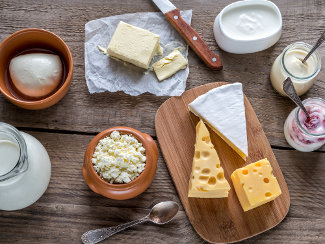
How to have Dairy Without the Guilt
Dairy: the ultimate controversy in health for the last 10 years. Should we eat it? Is it really healthy for us? Just try and google, “should I eat dairy?”. You’ll be sifting through articles until your eyes cross, and you’ll leave your computer just as confused as when you started. For instance, the FDA says milk gives you the calcium you need for healthy bones. While the health and wellness blog you follow tells you, milk is acidic and will actually lead to osteoarthritis. So who is right?
The answer, much like the question, is complicated. Mostly because the milk, cheese and butter we buy in the supermarket are a far cry from the dairy our grandparents had. The cheese of previous generations was made with full fat, came from cows raised on an open farm just down the road, and was unpasteurized. Today, most of the dairy available to us is pasteurized, contains only partial fat, has a ton of additives to replace the fat and elongate shelf life, and comes from factory farmed cows. Just from those facts alone the dairy of today doesn't sound so appetizing. But don't fret my grilled cheese fanatics, with a little education and smart decisions you can still enjoy your favorite milky treats.
Milk
Anyone who has moved in with a significant other has come home after the first shopping trip and cringed at the sight of the wrong type of milk in the fridge (except for those lucky few who have matching milk preferences, that's soul mate status). For the rest of us, we begin a game of wits about whose milk is the best choice. Well, non-milk soul mates, let's settle that score right now, it's organic whole milk.
Milk contains fat soluble vitamins, A D E K. Fat soluble means the body cannot absorb these vitamins by themselves, they need to be accompanied by fat. What a great coincidence that milk naturally contains the fat needed to aid the absorption of these vitamins. However, when we start taking the fat to make 1%, 2%, and skim milk, the fat soluble vitamins are not as easily absorbed, if at all.
Cheese
The average American eats 23 pounds of cheese per year. That’s a lot of cheese. Especially considering that it is the leading source of saturated fat in the American diet. Also, most processed cheeses contain additives like cellulose, food dye, soy lecithin, and corn starch, just to name a few. Even organic options are not always free from additives. So how do you enjoy cheese without the guilt? The answer is: Raw Milk Cheese.
Raw milk cheese is cheese that is made from unpasteurized milk. I know every sixth grader in America has given praise to Louis Pasteur via glue sticks and poster board for saving us from sure death by unpasteurized foods,but cheese that is unpasteurized is very safe. Traditionally cheese is aged, and during this aging process good bacterial cultures grow. They naturally help protect against the growth of harmful strains of bacteria in the cheese that will lead to foodborne illness. These raw milk cheeses do not have any additives because they have everything they need from this very healthy aging process. As an added benefit, raw milk cheeses usually have a bolder, more distinct taste. That is something a cheese lover can’t say no to.
Butter
If you asked my grandmother what her favorite food is, I’d be willing to bet the twenty dollars in my pocket she'd say butter. And she's definitely not alone. Butter has a unique taste that is very hard to mimic. Its creaminess makes any recipe it's in that much more decadent. However, with so many choices in the dairy case it can be hard to make the correct one. Let me help you, the correct choice is organic cultured grass fed butter, or ghee.
If you must use butter in your cooking, use butter that contains healthy bacterial cultures and comes from grass fed cows. These types of butter will actually contain some good omega fats and vitamins like A, and probiotic cultures that promote intestinal health. Ghee is also a great choice because it is more easily digested. Ghee is known as “clarified butter” and it has been used for thousands of years. It is made by separating the milk solids, such as proteins and lactose. This leaves a golden creamy solution that is solid at room temperature. So if you just can’t get into substituting coconut oil for butter, try one of these and you will not be disappointed.
The dairy we eat today can be a little scary and honestly not very good for our health. However, if you make these simple changes, your body will be sure to thank you. Also, don't forget that dairy should not be a major food group in your diet. As healthy as these options can be, they still contain a large amount of saturated fat. The same saturated fat that has been shown to lead to Heart Disease. So even though these alternatives might have a higher price tag, keep in mind that dairy should be a small little box on the top of your food pyramid, not one of the building blocks. This means your heart, stomach and wallet will end the day with a smile.
The information in this article is for general educational purposes only, and should not be construed or interpreted as medical advice. Always seek the advice of your physician or other qualified healthcare provider regarding any medical condition or treatment, and before undertaking a new heathcare regimen. Never disregard professional medical advice or delay in seeking it because of something you have read in this article or any linked materials.